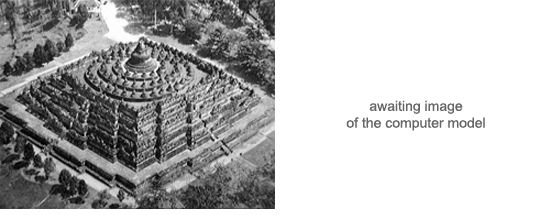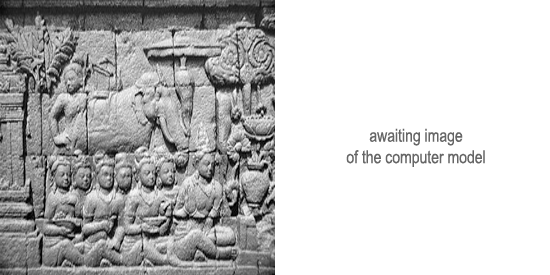|
3DVisA Resources
3DVisA Index of 3D Projects: Architectural and Urban Studies
Borobudur Temple, Indonesia
Keywords: Borobudur, South-East Asia, sacred architecture, 3D model, VRML.
A masterpiece of Indonesian architecture, the spectacular Borobudur Buddhist Temple in central Java dates from the 8th and 9th centuries and the rule of the Sailendra dynasty.
It is a steep, terraced, stone-clad earth structure; it rises from a square, 150m-wide plan, and culminates with circular tiers of 72 openwork stupas, topped by a large
central stupa in the form of a cone. Each stupa houses a statue of the Buddha. The monument symbolises the Mahayana Buddist cosmic system: each of the nine terraces
corresponds to spiritual stages leading to nirvana. The exuberantly rich sculpture illustrates sacred Buddhist texts and the life of Buddha. The low-relief sculpture
covers some 1,300 stone panels and a total surface area of 2,500 sq. m. Although disused since around 1000, Borobodur is one of the best preserved Buddhist temples in South-East Asia.
Between 1973-1982 the complex underwent extensive restoration which was supported by UNESCO and led by the archaeologist Professor Soekmono. Borobudur was added to the
UNESCO World Heritage List in 1991.

Fig. 1. Aerial view of the Borobodur Temple, before 1931 (After Krom and van Erp, Plate 11) and the VRLM model of the same. © Jigsaw Project. Reproduced with kind permission.
The 3D visualisation of the structure and sculpture of the Borobudur stupa was underatken in 1999 by Michael Greenhalgh, Professor of the History
of Art at the Australian National University at Canberra. The main aim of the project was to investigate whether a 3D computer model can serve as a detailed and accurate record
of a historic monument as complex as Borobudur. The use of VRLM models in teaching was also investigated.
High-quality black and white plates published in 1920-31 by Krom and van Erp were used as a source for the model. The photographs were digitised not by scanning, but captured with
a Sony DXC-930P 3-CCD video camera; individual frames were saved as 1.6 megapixel images. An AutoCad model of the stupa (a 1.2MB file) was produced and exported to VRMLout software.
The CAD skeleton was enhanced by further modelling by hand by the programmer, Dr A.J. Limaye. Also used in the process were Perl scripts programmed in house. The hardware included
a variety of then-powerful PCs running Linux, with large monitors. Back-projection onto screens was used for room-sized HMD-manipulated examination of the stupa.

Fig. 2. Borobodur Temple. Detail of sculptural decoration in the third gallery, before 1931 (After Krom and van Erp, Plate 2.3) and the VRLM model of the same. © Jigsaw Project. Reproduced with kind permission.
It became clear in the course of this research that in terms of iconographic accuracy
the surviving historic photographs were superior to the computer model.
This three-year project was supported by the Australian National University as part of the larger, Jigsaw Project; the grant amounted to aprox. GBP40,000.
Project dates: January 1999 - Ended (never completed) 2001.
Resource status: The project website offers an archive of iconographic and historic material, as well as
the description and demonstration (?) of the model.
Contributors: The project was directed by Professor Michael Greenhalgh, Department of the History of Art, Australian National University, Canberra; programming by Ajay Limaye, Supercomputer Group and Visualization Studio, Australian National University.
Sources and further details: The Borobudur Project website.
UNESCO World Heritage List: Borobudur, with a link to 360 degree tour (panographies).
Anom, I. G. N. (ed.) (2005), The Restoration of Borobudur, UNESCO World Heritage series.
Greenhalgh, M. (2000), '
Learning Art History in Context: An Image Database & VRML Model of Borobudur', Journal of the Association for History and Computing, vol. iii. no. 1, April. Also available in PDF.
Greenhalgh, M. (2001), 'A Virtual Reality in Architecture; A VRML Model of Borobudar (Java)', Moving the Image: Visual Culture and the New Millennium, Proceedings of the Sixteenth Annual CHArt Conference,
Courtauld Institute of Art, London, 1-2 September 2000. Bentkowska, A. and Sunderland, J. (eds), London: Computers and the History of Art.
Greenhalgh, M. (2005), 'Virtual reality, relative accuracy: modelling architecture and sculpture in VRML', Images and Artefacts of the Ancient World, Bowman, A.K. and Brady, M. (eds.),
London: British Academy, pp. 45-58.
Krom, N. J, and Erp, Th. van, (1920-31), Beschrijving van Barabudur, 2 vols, 3 portfolios of plates, The Hague.
Record compiled by Anna Bentkowska-Kafel from the material provided by Professor Michael Greenhalgh, 9 October 2007. Last updated: 11 April 2007.
3DVisA gratefully acknowledges the help of Professor Michael Greenhalgh with preparation of this record.
© Jigsaw Project and 3DVisA, 2006.
Back to the list of 3D projects
| 